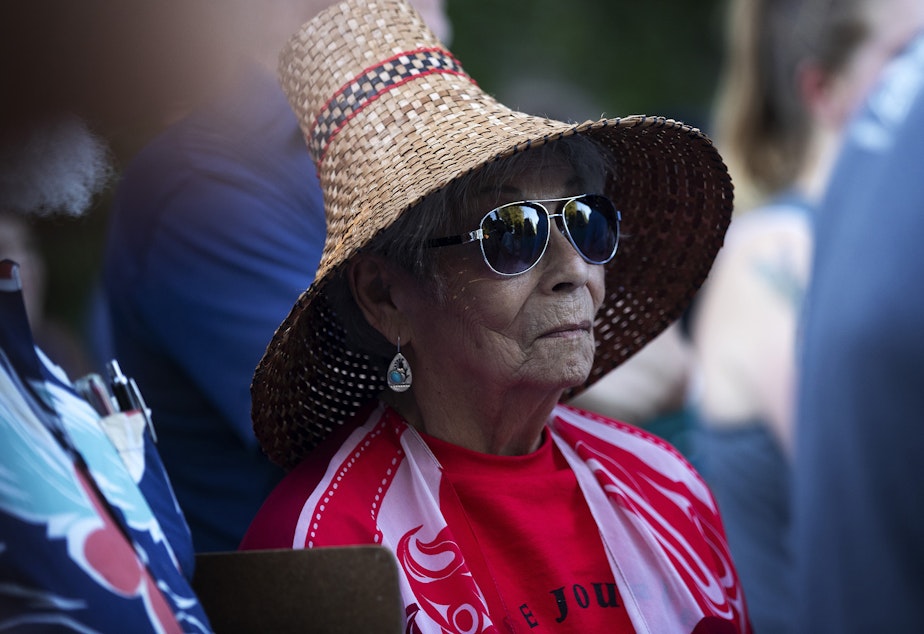Climate activists try to block tree removal in Seattle
Snoqualmie Tribe says Wedgwood protest is about more than one tree
 1 OF 5 Cecile Hansen, chair of the Duwamish Tribal Council, attends a gratitude gathering for Luma, a roughly 200-year-old culturally modified cedar tree at risk of being cut down for a development project, on Tuesday, July 18, 2023, in the Wedgwood neighborhood of Seattle.
1 OF 5 Cecile Hansen, chair of the Duwamish Tribal Council, attends a gratitude gathering for Luma, a roughly 200-year-old culturally modified cedar tree at risk of being cut down for a development project, on Tuesday, July 18, 2023, in the Wedgwood neighborhood of Seattle.Reports started circulating last Friday that an activist had climbed and camped out in a giant tree in Seattle's Wedgwood neighborhood. A developer planned to remove the approximately 150-year-old Western redcedar to make way for a multi-unit housing project.
Over the last week, crowds of tree-loving community members joined the protest. Jaime Martin is the executive director of governmental affairs and special projects for the Snoqualmie Tribe. She spoke to KUOW’s Paige Browning about the significance of this and other area trees.
This interview has been edited for clarity.
Paige Browning: What is your understanding of why removal was approved for this tree, one of the relatively few left in the Seattle area of this stature?
Jaime Martin: Yeah, it's perplexing. Honestly, I've spoken with multiple tree service providers that are registered in the city. And they've also remarked that they were surprised that it was permitted for removal. It's healthy. It's a gorgeous tree. It's on the very edge of the lot, so it's not impeding building from happening in a responsible way.
A lot of folks are not familiar with Culturally Modified Trees, or CMTs. And really, the only way to become aware of them is to make sure that there's proper tribal consultation prior to a project being permitted so that tribes — Snoqualmie and others in the area — can make sure that something like a CMT is not being impacted. In this case, it appears the city did no assessments, and did not consult with any tribes on this issue. That has resulted in very unfortunate projects being permitted by the city.
Can you say more about what CMTs are?
CMTs are often in this area. They're redcedars and sometimes other tree species. They can be found all across the Pacific Northwest, all the way from Alaska to Northern California. In this region, there are a few characteristics that they tend to have. Sometimes you can see a spot where a tribe harvested cedar bark from the side of trees. This is done in a way that's very sustainable and is a traditional practice where the bark can be removed in a way that the tree still lives. And then the bark can be used for things like weaving.
Some of the other characteristics you see on culturally modified trees are bent branches that are indicating various types of information. Sometimes it's communicating something like a directional sense even, so kind of like a living signpost, if you will.
Was there knowledge ahead of time that this particular Western redcedar was culturally modified?
Not to my knowledge, although this area, the Wedgwood neighborhood of northeast Seattle, was only developed in the late 30s and 40s. The area was heavily used by tribes before that. So there were some sites in the area, there were trails, and so it's known as an area that is where CMTs are prevalent.
The developers in the area, in the 1940s, purposefully retained these trees because they saw their value. They're really beautiful. They provide so many ecological benefits, and they really make the neighborhood the neighborhood that it is. So it's not necessarily that this particular tree was known to be a CMT, but there are CMTs prevalent in the area.
More people are learning now about culturally modified significant trees because of this one redcedar in Wedgwood. Can you tell me what exactly the Snoqualmie Tribe is asking of the Seattle City Council and the mayor now?
We're asking the mayor to issue an executive order that would basically direct staff to halt the implementation of the new tree ordinance that goes into effect on July 30. This would give us time to make sure that there's proper and meaningful tribal consultation that occurs, and that CMTs and other cultural resources that would be impacted by that tree ordinance can be included in that language before it goes into effect.
City of Seattle officials told us today that the Department of Construction and Inspections does not have the legal authority to revoke the permit to cut down the tree, as it already approved the permit to construct three housing units on the site where the redcedar sits.


No comments:
Post a Comment